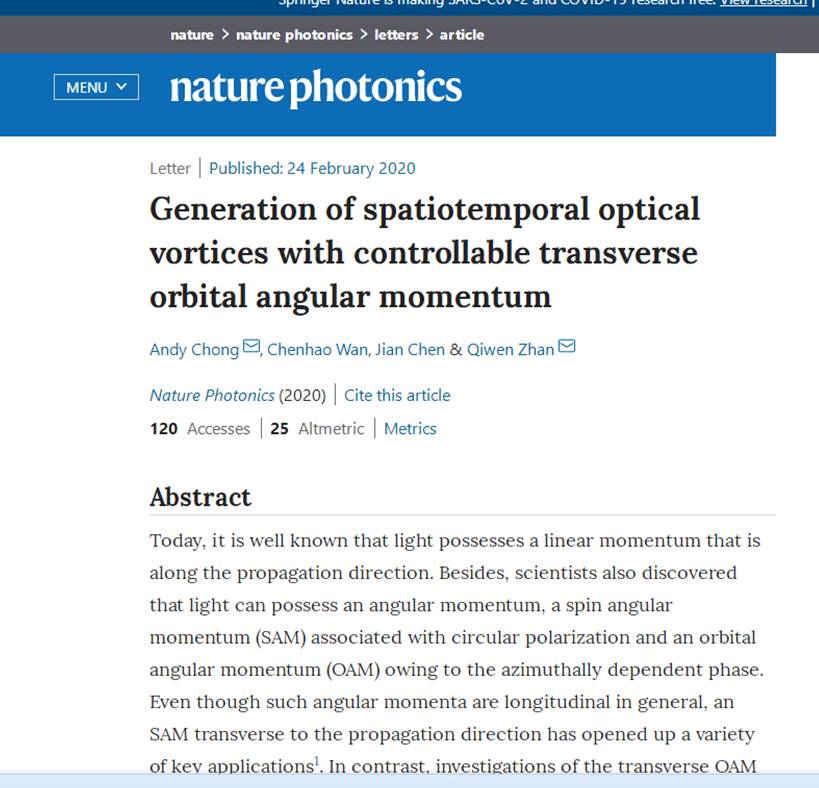Recently, the Future Optics International Laboratory led by Academician Zhuang Songlin and Academician Gu Min of University of Shanghai for Science and Technology has once again made a major breakthrough in the field of photon orbital angular momentum research. The nanophotonics team led by Prof. Zhan Qi-Wen demonstrated for the first time a new type of light field with spatio-temporal vortex phase and carrying photon transverse orbital angular momentum from theory to experiments, which has created a brand new degree of freedom of photon orbital angular momentum, which has great research and application value in the fields of optical communication, optical information processing, quantum optics, particle manipulation, particle collisions, relativistic space physics and other fields with greater research and application value. The research result Generation of spatiotemporal optical vortices with controllable transverse orbital angular momentum was published online in the world's leading optics journal Nature Photonics.
Recently, the International Laboratory of Future Optics led by Academician Songlin Zhuang and Academician Min Gu from USST has made another significant breakthrough in photonic OAM. Professor Qiwen Zhan's team in Nanophotonics has demonstrated, for the first time, a new type of light field with spatiotemporal vortex phase and carrying transverse OAM, opening up a new degree of freedom in photonic OAM. This research has great research and application value in the fields of optical communication, optical information processing, quantum optics, particle manipulation, particle collisions, and relativistic space physics. The research paper titled Generation of spatiotemporal optical vortices with controllable transverse orbital angular momentum has been published online in the prestigious journal Nature Photonics.

Background:
Photons have linear momentum along the direction of propagation of the beam. Photons can also carry angular momentum, including spin angular momentum associated with circular polarization and orbital angular momentum associated with vortex phase. Typically, the spin angular momentum and orbital angular momentum of photons are along the direction of beam propagation. Photon angular momentum has been widely studied and applied in high-speed optical communication, particle manipulation, holographic imaging, quantum optics, and other fields. For example, in particle manipulation, the spin angular momentum of photons can cause particles to rotate around their own axis, while the orbital angular momentum of photons can cause particles to rotate around the center of the beam, similar to the rotation and revolution of the Earth. In recent years, research has shown the existence of transverse spin angular momentum of photons perpendicular to the direction of beam propagation in high numerical aperture focused light fields and transient wave fields. The transverse spin angular momentum of photons has received widespread attention and research in the context of photon spin-orbit coupling, quantum optical communication, and surface plasmon polariton propagation. However, the transverse orbital angular momentum of photons perpendicular to the direction of beam propagation has not been reported yet.
Innovative Research
Transverse orbital angular momentum of photons is perpendicular to the direction of beam propagation and is associated with the phase of a multi-color vortex. The optical wave packet is a spatiotemporal structure with a transverse vortex, resembling a rapidly moving cyclone. The transverse orbital angular momentum of photons can theoretically have an infinite number of values, also known as topological charges, which can be controlled by the phase of a multi-color vortex.

The generation of spatiotemporal optical vortices is based on the Fourier transform from the spatial frequency-frequency domain to the spatial-temporal domain. It is difficult to directly apply a spiral phase in the spatial-temporal domain, but it is relatively easy to apply a spiral phase in the spatial frequency-frequency domain. This can be achieved in the laboratory using optical phase elements such as gratings, cylindrical lenses, and liquid crystal spatial light modulators. Spatiotemporal wave packets carrying different topological charges of transverse orbital angular momentum can be controlled by modulating different vortex phases using liquid crystal spatial light modulators. The vortex phase in the spatial frequency-frequency domain remains after the Fourier transform in the spatial-temporal domain, thus generating controllable spatiotemporal optical vortices.

The spatiotemporal optical vortex wave packet is a picosecond-scale chirped pulse. By precisely superimposing an ultrashort pulse with the wave packet using a precision motorized stage, a set of interference fringes is formed. Based on the measured interference fringes, the vortex phase distribution with a singularity at the center in the spatial-temporal domain can be reconstructed, which is consistent with theoretical expectations. The interference fringes can also be used to calculate the spatial intensity distribution of the spatiotemporal wave packet in three-dimensional space. In the spatial-temporal domain, the intensity at the position corresponding to the phase singularity of the wave packet is zero.


The breakthrough research on photon transverse orbital angular momentum represents another significant advancement in the field of photon orbital angular momentum at USST. This research has revealed a new optical field state and opened a new dimension in photon orbital angular momentum. It has broad application prospects ranging from the interaction between light fields and atoms/molecules, micro-nano structures, and devices, to macroscopic cosmology and relativistic studies.


